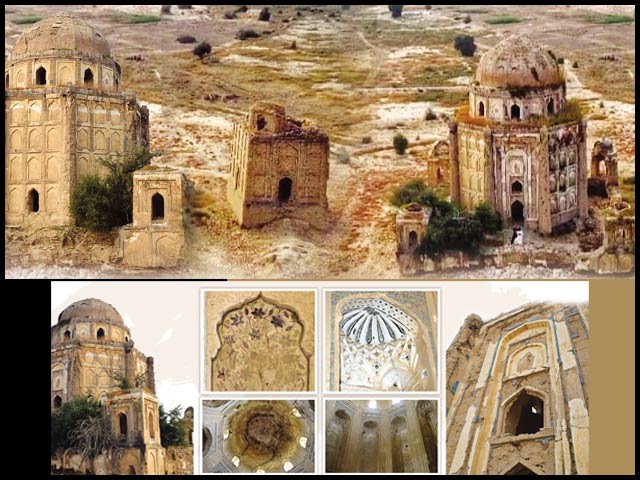Khanpur: Thus, the name of Balochistan continues to appear in the local and international media due to political upheaval, activities of miscreants and chieftains, but now with the help of social media, tourism and beautiful places here are also brought to the public. Is.
You all are familiar with Balochistan’s beautiful mountain ranges, blue springs, rivers, apple and cherry orchards, and snowfields, but it is also a treasure trove of earth’s history, a treasure that few have reached.
Many mysteries are buried in the bosom of this land, many historical buildings and tombs are in a very dilapidated condition, one of which will be mentioned in the next line.
Jhal Magsi is the second largest district of Naseerabad Division of Balochistan, known for its scenic spots such as Dargah and Chashma Pir Chhattal Noorani, Moola River, and Pir Lakha.
Mian Sahib Tomb, Moti Ghauram Tomb, Bhutani Tomb, Dargah of Fatehpur Sharif, Iltaz Khan Tomb and Khanpur are historical places of this area. I will mention here the tomb of Moti Ghauram.
The tomb is situated north of Jhal Magsi in the deserts of Mirpur and near one of the spreading tributaries of the Mula river. The mausoleum of Sardar Ghoram Lashari and Mai Moti was once called the “Taj Mahal of Balochistan” due to its beauty.
The octagonal building has beautiful blue work, raised arches on all four sides, two-storied domes and beautiful carvings on the arches inside.
Seeing the condition of this historical tomb was heartbreaking. There was a history that was just about to be erased.
This mausoleum is built on a broad platform with open and domed shrines at each corner. There is an arch on each side of these tent-like khargahs and a small dome on top, while this platform is also decorated with different closed arches on each side. These square huts are open on four sides covered with domes plastered with lime mortar.
The main mausoleum is built in the eight-sided (eight-cornered) style. In the center of each octagon is a pillar that is wider at the base and narrows from the bottom to the top.
The main entrance is on the east side while the central directions have open arches on the lower level to provide light and ventilation.
Internally, each of the octagonal arches has a deep niche finished with glazed tiles of rectangular and vertical panel design. Vertical arched niches are crowned with pointed arches.
Blue tile work has been done around and above these arches, while blue and green colors have been used for various carvings.
Sixteen small-sized arches are built above the wall arches, eight of which are open and eight are closed. The dome of the tomb stands on these arches. No decorative work is found in the interior of the dome.
The architectural and decorative features of the tomb are closely related to Central Asian / Timurid architecture which is also reflected in its decoration. If only the carvings of this mausoleum had been preserved in their original state, those who are interested in buildings and constructions could have found a lot here.
There are traces of two graves inside the tomb, on which there is no inscription of any kind. Which of them is the grave of Ghoram Lashari and Moti cannot be said with certainty. If you come out of the tomb, one side of the platform has completely sunk into the ground, from which some arched windows below are visible, which means that there must have been a basement or a place under this tomb.
Perhaps because of this, the locals saw the treasure of Qarun here like any other historical place.
The mausoleum was abused by the natives, who dug it up again and again in the lure of some hidden treasure (which was not even remotely in question). Bricks were removed from somewhere, tiles and stones were removed from somewhere.
The limit was reached when I reached there with my Baloch friends, two or three local men rushed there and told us that if we find anything from digging here, then we also have to contribute (perhaps they want us to reach here in search of treasure). No team was understood.
My friend Mahmood Khosa said that this is the situation of people here that they do not hesitate to damage this place when they get an opportunity.
A small mosque was also built on the northern side of the mausoleum. Built on a raised platform, this two-storied mosque is square in shape with arched doors on three sides and a central arch on the western side.
The mosque appears to have been built of neat little brick both internally and externally, while a large dome on small arches topped it, which is now martyred. Bricks are scattered around and inside the mosque.
It is my painful appeal to the Government of Pakistan, Department of Archeology and Government of Balochistan to do something to protect this heritage of Godara Jhal Magsi. If nothing else, protect it from further destruction by putting a wall around it.
God, do not think of it as a precious heritage of the country, but save it as the grave of your chiefs so that tourists like me do not have to come here.
(function(d, s, id){
var js, fjs = d.getElementsByTagName(s)[0];
if (d.getElementById(id)) {return;}
js = d.createElement(s); js.id = id;
js.src = “//connect.facebook.net/en_US/sdk.js#xfbml=1&version=v2.3&appId=770767426360150”;
fjs.parentNode.insertBefore(js, fjs);
}(document, ‘script’, ‘facebook-jssdk’));
(function(d, s, id) {
var js, fjs = d.getElementsByTagName(s)[0];
if (d.getElementById(id)) return;
js = d.createElement(s); js.id = id;
js.src = “//connect.facebook.net/en_GB/sdk.js#xfbml=1&version=v2.7”;
fjs.parentNode.insertBefore(js, fjs);
}(document, ‘script’, ‘facebook-jssdk’));


